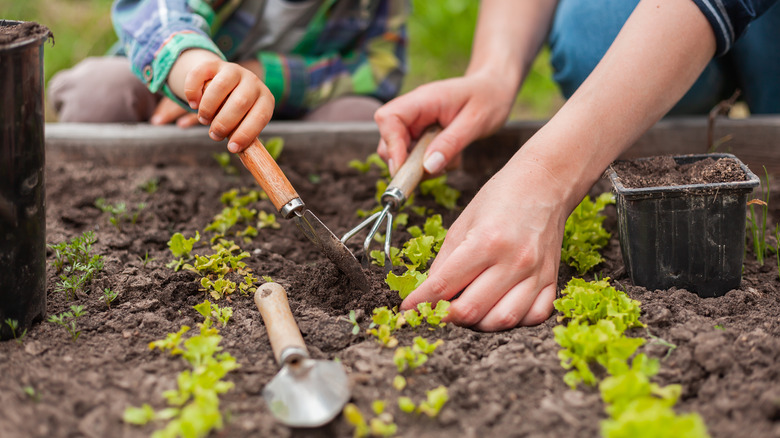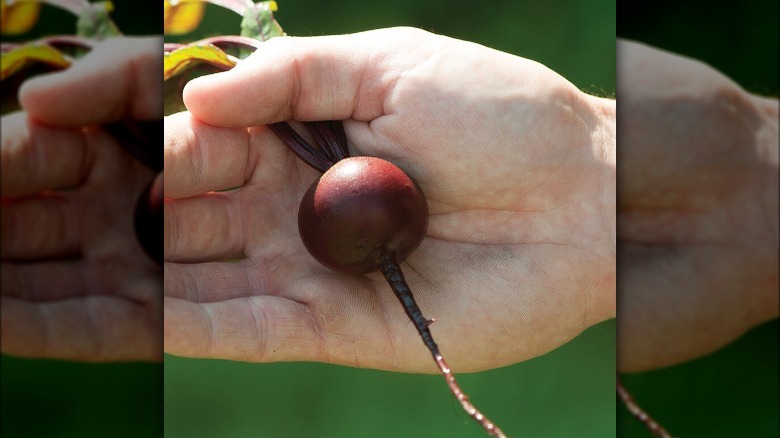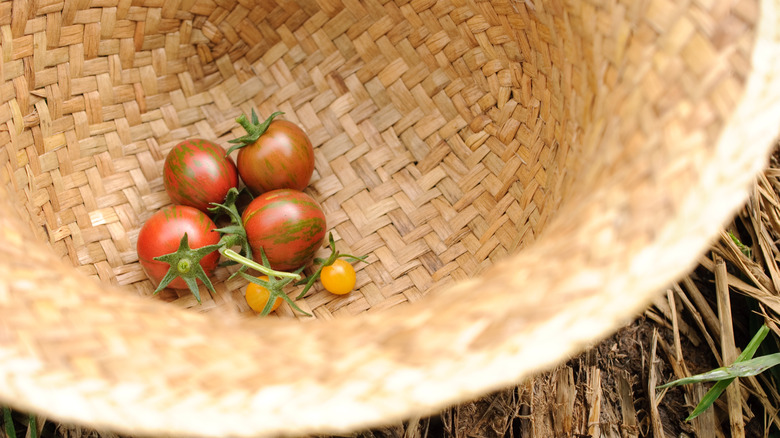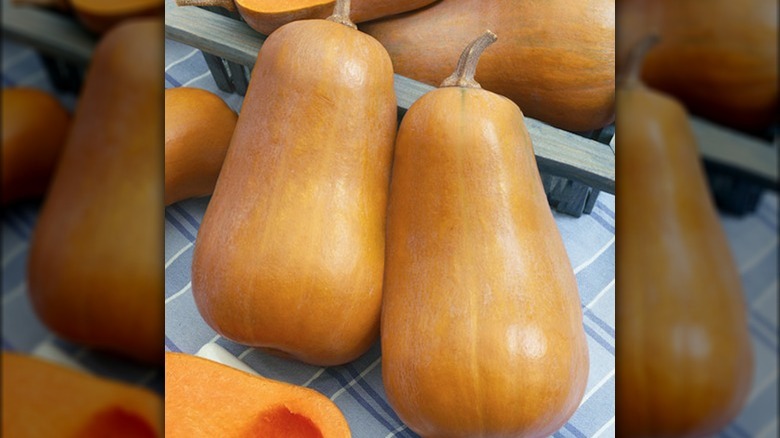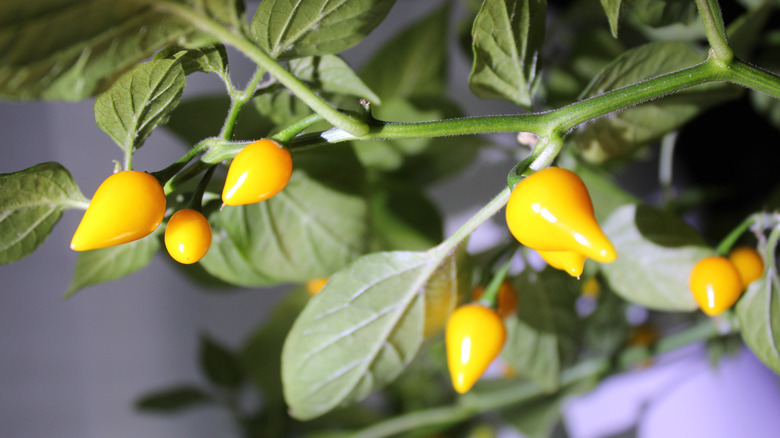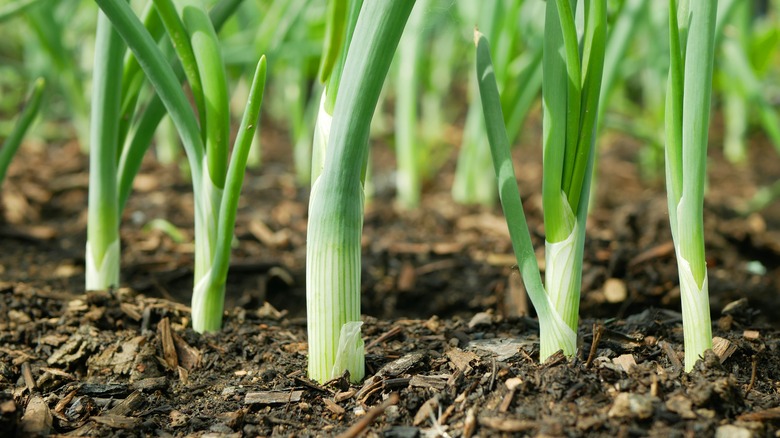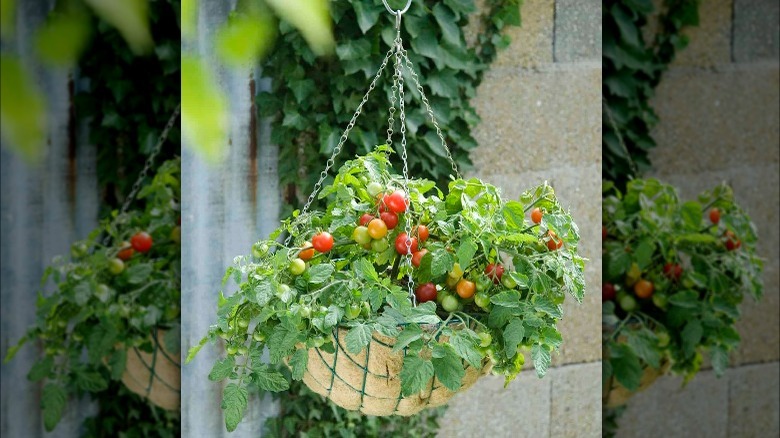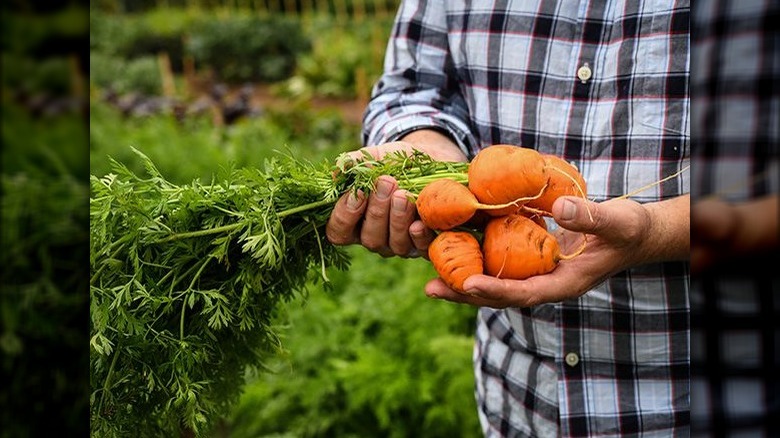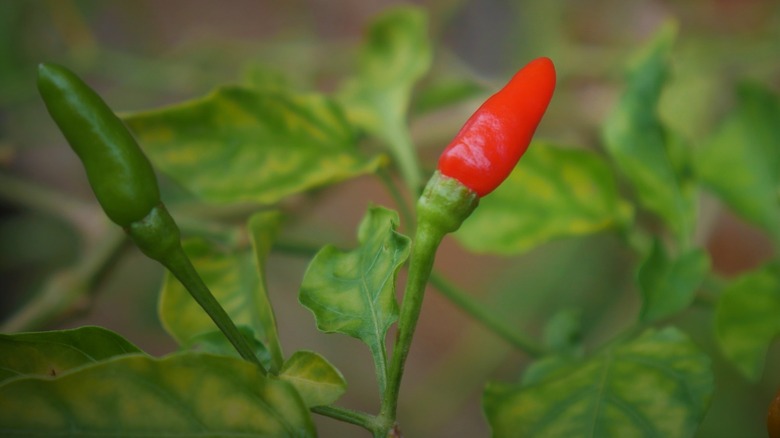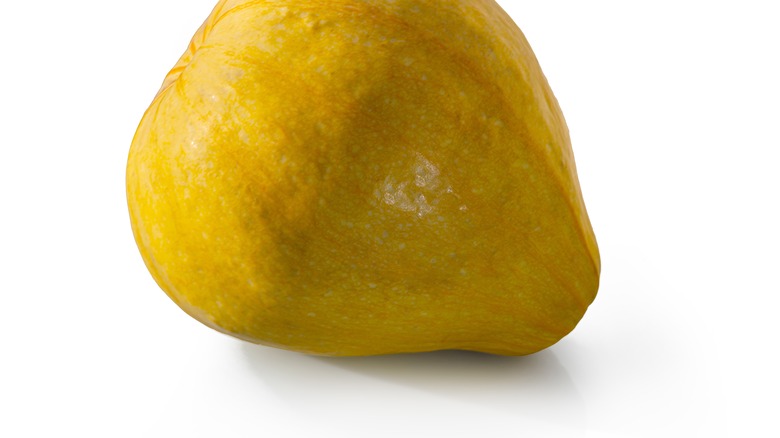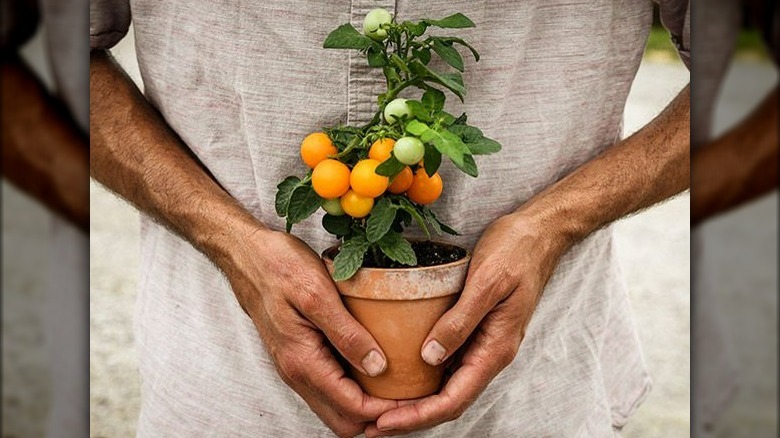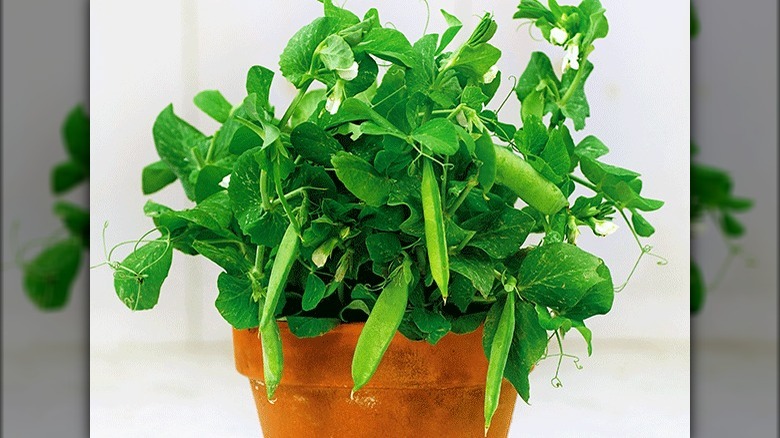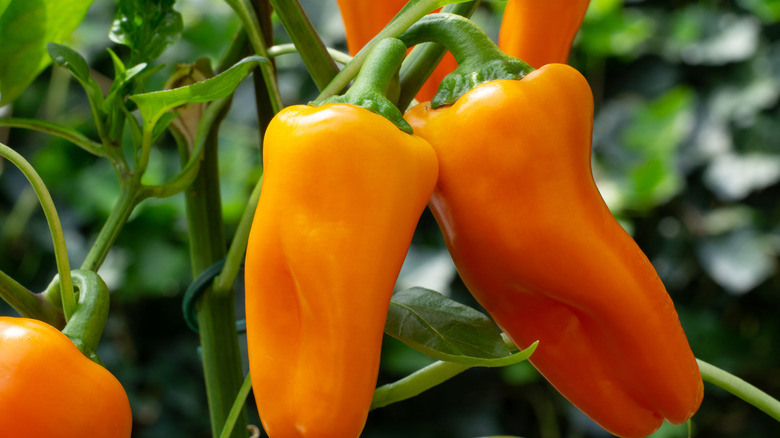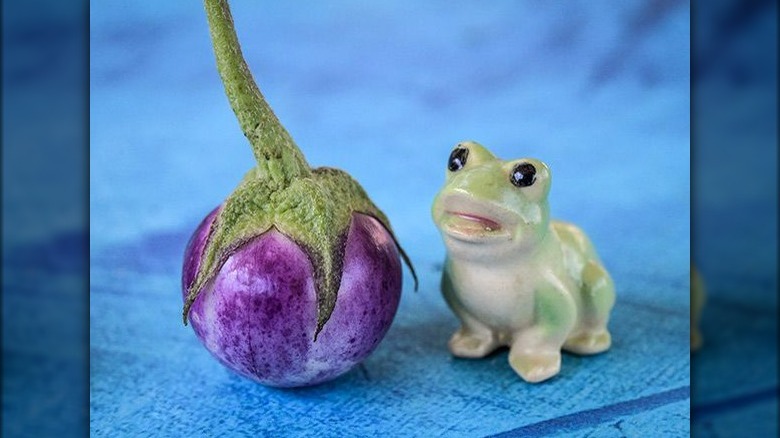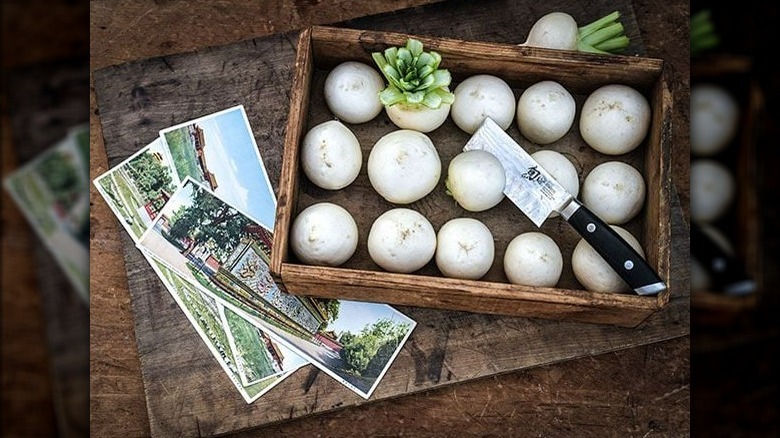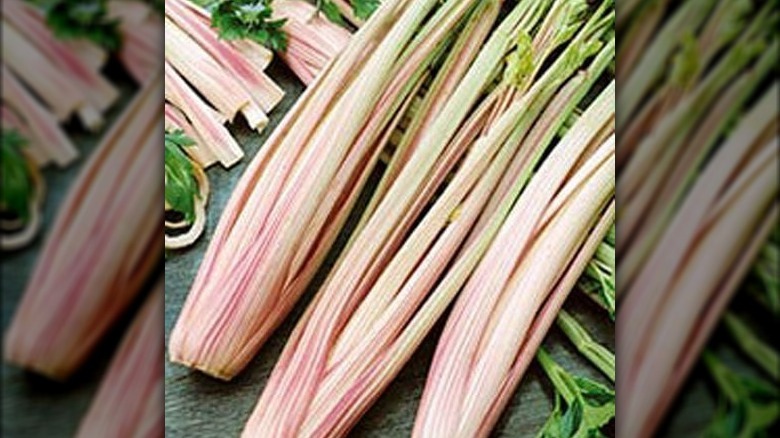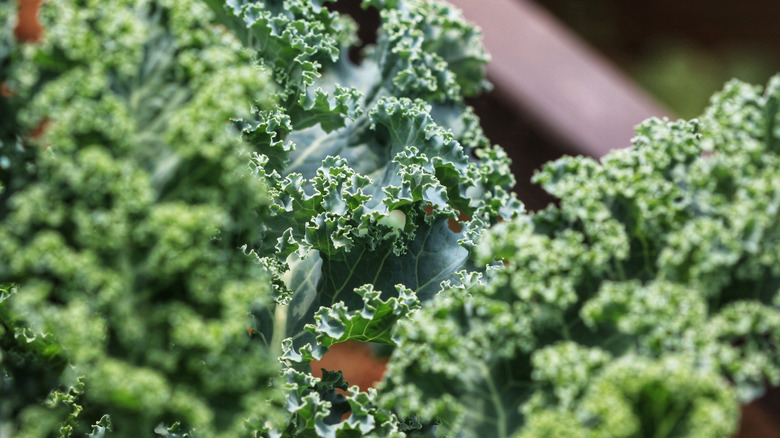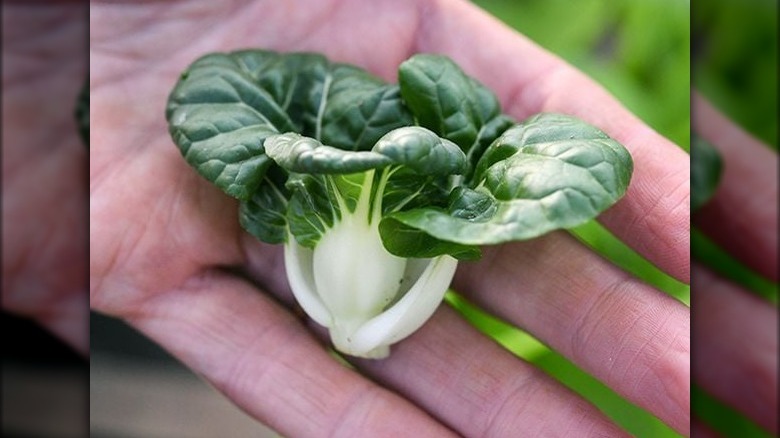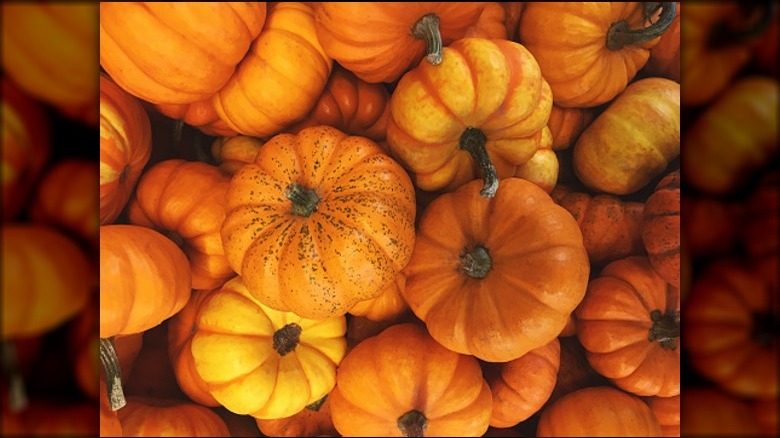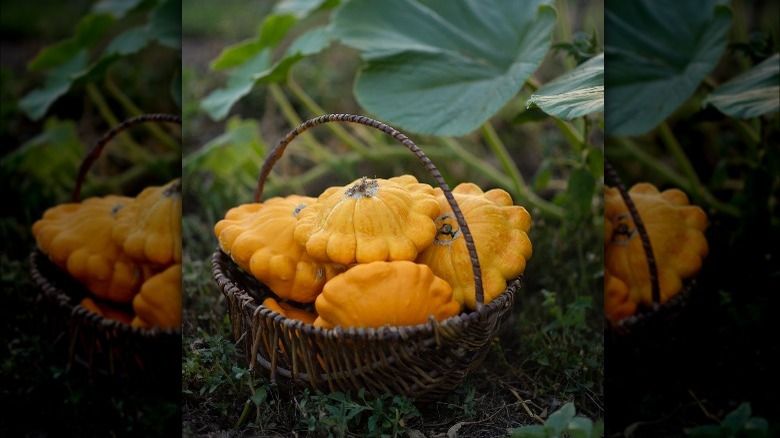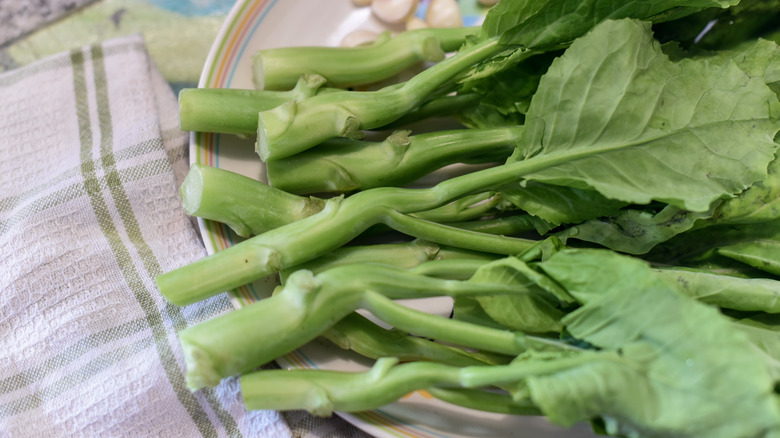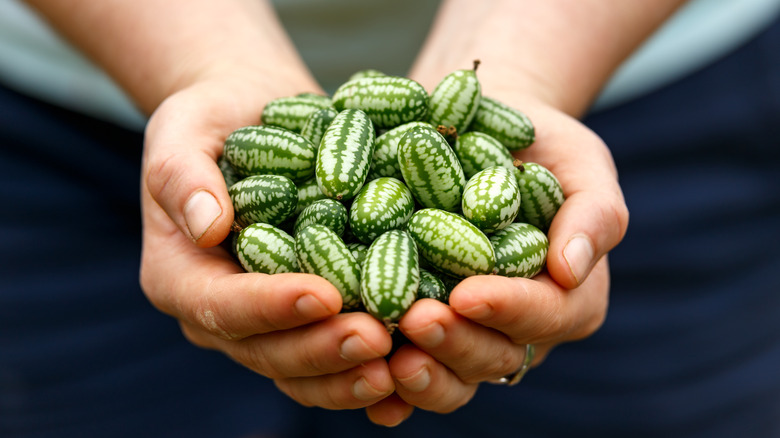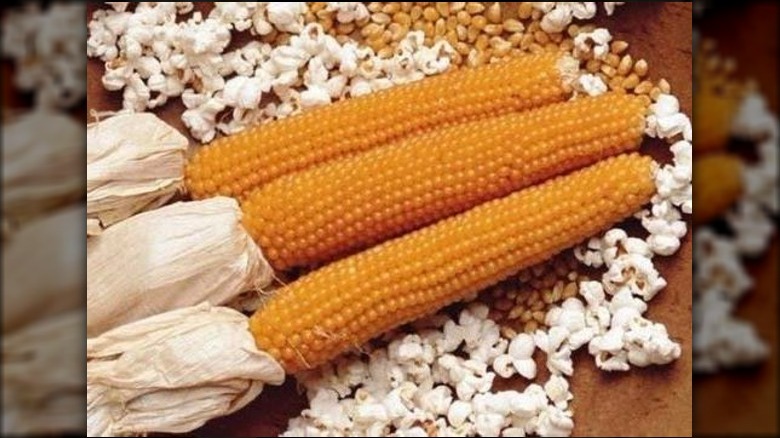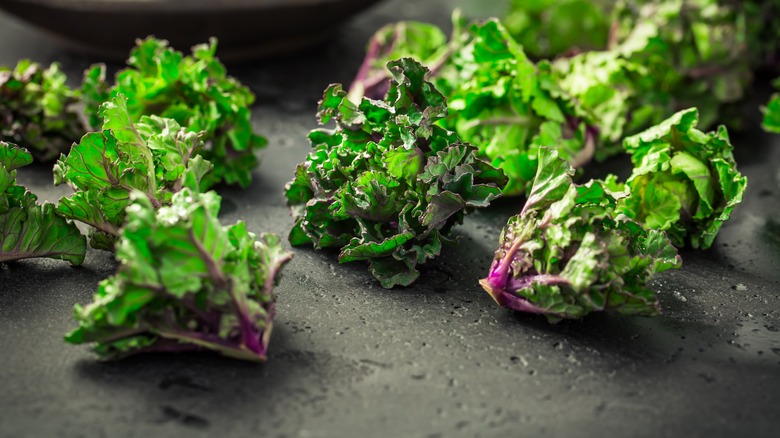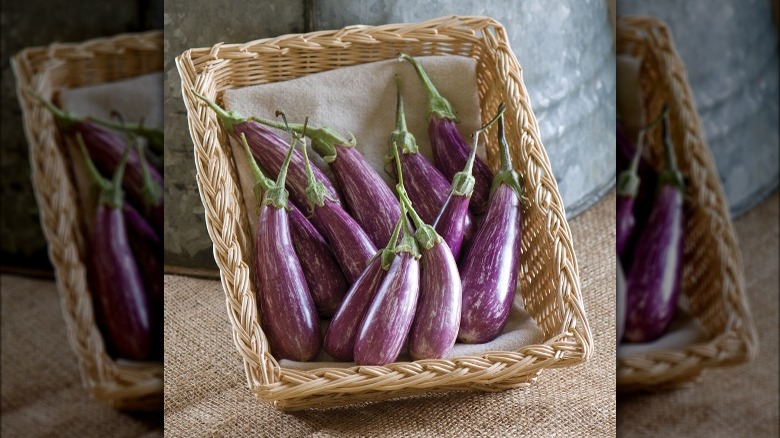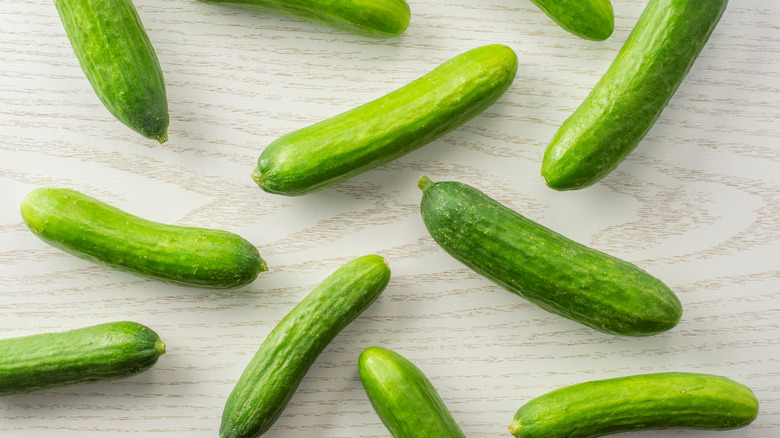25 Miniature Veggies You Can Grow In Your Backyard
Gardening from your backyard is a great way to save money on produce, liven up your outdoor space, and learn how to become even more self-sufficient. It feels great to eat what you've harvested with your own two hands while also knowing that your fresh vegetables are grown without pesticides and with all your loving care. However, if you have a tiny backyard, you might think that achieving this dream is impossible. It's not. Many miniature plants produce miniature veggies that you can grow with very limited space.
Creating a vegetable garden at home can become a healthy year-round hobby that stimulates your mind and body while connecting you to the earth. Each of these 25 tiny crops is produced by a plant that has been cultivated for its self-pruning abilities or compact growth habit. Many of them boast prolific yields that call for daily harvesting. With the right sort of care, your patio garden will provide you with more veggies than you could imagine.
1. Baby beets
You can get baby beets (Beta vulgaris) in two ways. The first is by harvesting regular beets prematurely, and the second is by planting babybeat beet seeds. The latter is recommended because true baby beets grow to become the perfect size every time, assuming they are raised with the right care. These plants produce the best harvest when they are grown in loamy soil during consistently cool weather. The soil will need to be watered regularly to keep browning and scab at bay.
2. 'Micro Tom' tomato
Likely, you are already familiar with grape and cherry tomatoes that boast a tiny and uniformly round look, however, those are not the only miniature tomatoes available to you. 'Micro Tom' tomato plants (Solanum lycopersicum) flower and fruit at the same time. Unlike traditional tomato plants, this hybrid stays small, typically just 4 to 6 inches tall in adulthood, thanks to its self-pruning gene. During harvest time 'Micro Tom' tomato plants provide dozens of petite tomatoes that are dark red in color and quite delicious in salads, pasta dishes, and more.
3. 'Honey Baby' butternut squash
'Honey Baby' butternut squash (Cucurbita moschata) is a delicious miniature version of butternut squash that usually weighs less than 2 pounds. Produced from plants that measure just over 1 foot tall, this squash variety can be grown almost anywhere, including in your own backyard. Named for its sweet flavor, the 'Honey Baby' cultivar is a great alternative to typical butternut squash that require more space, nutrients, water, and effort to raise.
4. Biquinho yellow pepper
Although they are often grown for their ornamental value, Biquinho yellow pepper (Capsicum chinense) has a pretty good flavor too. These tiny yellow peppers are very mild, reaching only 500 to 1000 Scoville Heat Units, so they're great for use in mild salsa or pepper pesto. Be sure to provide these peppers with plenty of direct light and keep the soil moist. Although the plant is drought-tolerant, it will provide you with tastier fruit when you are attentive to its needs.
5. Scallions
Scallions (Allium fistulosum) are among the most well-known miniature veggies. Also referred to as green onions or bunching onions, the plant is fairly easy to grow in a small backyard. Scallions require frequent watering and attention during their growing period. These small onions are easily suffocated by weeds, so you'll need to watch carefully and pull weeds as they appear. It can be hard to tell when scallions are ready to harvest. Most often, gardeners decide to pull them from the soil when the green stalks are about 7 inches high.
6. Terenzo tomatoes
Terenzo tomatoes (Solanum lycopersicum 'Terenzo') are known for their cherry red color and low-to-the-ground growing habit. This plant, which provides backyard gardeners with a surprisingly high yield, only grows to about 16 to 20 inches tall. As a trailing plant it's great for hanging baskets; it could even be grown on your patio or inside your kitchen if you have limited outdoor space. Terenzos are described as sweet-tasting tomatoes that would be the cherry on top of a fruity salad with a vinaigrette dressing.
7. Parisienne carrots
The Parisienne carrot (Daucus carota subsp. Sativus) is an unusual vegetable with a near-spherical shape. They're great for use in stews or for pickling. These carrots are rarely larger than a couple of inches in diameter, and are reportedly very easy to grow. As one reviewer on Rare Seeds noted, "I planted these as a lark in the early spring in part of the beet bed and, frankly, kind of forgot about them. Great germination, wonderful leafy fronds, and — wonder of wonders — actually got carrots!"
8. 'Birds Eye' pepper
The 'Birds Eye' pepper plant (Capsicum annuum 'Bird's Eye') is loved for its super hot fruits and gorgeous growth. The plant itself is quite ornamental, so much so that some will grow it simply for its aesthetic value. The small peppers change color from green to yellow and orange, and as they become riper, they show off purple and red skin. This pepper plant's fruit is actually ready for harvest during any of these stages, having a slightly different taste with each color.
9. Lemon summer squash
Another small and tasty squash cultivar is the lemon summer squash (Cucurbita pepo). This vegetable in the gourd family is named for its color and size, not its flavor. It's normally best to harvest these lemon lookalikes when they are no larger than an actual lemon. Be warned, the lemon summer squash plant is an aggressive grower; it does well trained on a trellis for upward growth. Most often, the plant will grow to become slightly smaller than 3 feet tall and wide.
10. Orange hat tomato
Orange hat tomato plants (Solanum lycopersicum) are so small they can fit in a 6-inch pot on your patio or kitchen counter. Only growing 6 to 9 inches tall in maturity, the plant is great for a small hydroponic setup or garden plot. The tiny tomatoes are orange in color, hence their name, and grow in clusters on the small plant. Keep in mind that these tomatoes prefer direct sunlight and consistent moisture while they are producing fruit.
11. 'Tom Thumb' peas
'Tom Thumb' peas (Pisum sativum 'Tom Thumb') appear on a compact plant that is much less work to grow compared to larger varieties. The pea plant grows to a height of less than 9 inches, and it won't need staking. It is frost-hardy so you can plant it before the threat of frost has ended and continue growing it in colder states that experience chills while the plant is still yielding veggies. Often, the 'Tom Thumb' plant is a go-to for those who don't have access to large garden beds.
12. Mini bell peppers
Anyone who finds an incredible amount of joy in tiny things will love growing mini bell peppers (Capsicum annuum) in their home garden. The shrunken peppers are produced in shades of green, red, yellow, orange, and brown. The fruits normally become only an inch tall and wide, so they are the perfect snacking size. You don't have to worry about the plant taking up too much space either because it rarely reaches more than a foot high. With direct sunlight, moist soil, and monthly fertilization, this plant will happily provide you with its sweet-tasting peppers.
13. Thai lavender frog egg eggplant
Thai lavender frog egg eggplants (Solanum melongena) are best described as bite-sized spherical fruits that come in several shades of purple. Though they are technically edible, the eggplants are quite seedy and feature little meat. Still, the purple, lavender, and green colors that the Thai lavender frog egg cultivar provides is incredibly ornamental. This is a plant that will look great in a small garden bed or potted on your outdoor patio.
14. Tokinashi turnip
Said to have a delicious mildly sweet flavor, the Tokinashi turnip (Brassica rapa) is a favored miniature crop that grows easily in small garden beds throughout the summer and fall. Though they require quite a bit of sunlight and somewhat warm soil, this turnip is best for harvest during the cooler months of autumn, just like larger turnips. The greens of the Tokinashi turnip are also edible, and ready for harvest whenever you like.
15. 'Peppermint Stick' celery
'Peppermint Stick' celery (Apium graveolens) is a relatively short and skinny variety of celery that features pink, green, and cream variegated stalks topped with darker green leaves. This smaller celery cultivar is known to taste just like common celery, only its stalks are more tender and better for snacking. They grow in full sun or partial shade and require consistent moisture to develop properly. Ensure that you plant your seeds in fertile soil in an area that provides temperatures above 70 degrees Fahrenheit.
16. Dwarf blue curled vates kale
Never growing much larger than 12 inches tall and 2 feet wide, the dwarf blue curled vates kale (Brassica oleracea var. acephala) is best grown in a large container or a tiny garden section. The cool season vegetable needs plenty of sunlight and well-drained soil to grow properly. Hardy to USDA growing zone 6, it's said that the curly blue-green leaves are extra sweet and tender after the plant has endured a light frost.
17. Hedou tiny bok choy
Hedou tiny bok choy (Brassica oleracea var. capitata) is a miniature variety of bok choy that is widely used in China as well as the United States. This small and leafy plant shows off dark green leaves and a white center, both of which taste delicious sautéed or stewed. The veggie can be grown indoors or outdoors as long as it is given 4 to 6 hours of direct light and temperatures consistently above 60 degrees Fahrenheit.
18. Jack Be Little pumpkins
Tiny pumpkins are one of the best things you can grow in a small backyard garden as autumn approaches. Jack Be Little pumpkins (Cucurbita pepo) are a favored cultivar with fruit that commonly reaches 2 inches tall and 6 inches wide. Though these little guys are usually used for decoration during the harvest season, they can also be baked or grilled. They have a citrus-like flavor when raw that can become sweeter with cooking.
19. Patty pan squash
Patty pan squash (Cucurbita pepo) is an unusual squash variety that shows off glossy yellow skin and a scalloped, diamond-like shape that resembles a spinning top or a flying saucer. Like its relative, the Jack Be Little pumpkin, patty pan squash can be used ornamentally or it can be eaten. Its taste is similar to yellow summer squash, but the meat is a bit more firm. When growing this type of squash, you'll need to provide it with fertile and well-draining soil as well as plenty of water for proper growth.
20. Chinese broccoli
Chinese broccoli (Brassica oleracea, Alboglabra Group) is a hardy plant that is usually eaten in Thai, Chinese, and Vietnamese dishes. Grown in full sun and moist but well-draining soil, this Brassica cultivar will develop quickly and become ready to harvest as soon as the stalk reaches 6 to 8 inches tall. They are ideal for planting in a small garden space as each plant produces a single stem. Chinese broccoli also does well when grown near walkways and as a container planting left on your patio.
21. Cucamelon
The Cucamelon (Melothria scabra) is a member of the cucumber family that looks like a minuscule watermelon. Also known as the Mexican sour cucumber or the mouse melon, this strange crop is said to taste like a sour cucumber. The plant that the cucamelon grows on looks a lot like your average cucumber plant only much smaller. It would easily fit in a backyard garden, especially when given a trellis or fence to climb.
22. 'Lady Finger' corn
Corn cannot normally grow in a backyard due to its size. 'Lady Finger' corn (Zea mays), however, is shorter and stockier, rarely surpassing 72 inches tall. Each corn plant produces a couple of ears that can be dried for popcorn. Plant this corn variety outside when soil temperatures are warmer than 60 degrees Fahrenheit. Like most corn, it will need lots of water, sun, and nutrients to grow properly. Remember, there are some plants that shouldn't be grown next to each other. Corn will not grow well near tomatoes, broccoli, or cabbage.
23. Kalettes
Kalettes (Brassica oleracea) are nutritious hybrid plants that were introduced to the public in 2014. A cross between kale and Brussels sprouts, kalettes are packed with vitamins K, C, and B-6. One kalette can easily fit in your hand, so they're definitely considered bite-sized. Though they can be eaten raw, you'll likely want to sauté, bake, or roast them for a better texture and taste. Their flavor is described as nutty and sweet. The outside of the veggie is most similar to kale, while the heart is much like a Brussels sprout.
24. Fairytale eggplants
If you weren't a fan of the spherical Thai lavender frog egg eggplants above, Fairytale eggplants (Solanum melongena) could be a better option for you. These lavender-hued veggies grow to become about 4 inches long and their shape resembles your common eggplant. They have limited seeds inside with quite a bit of delicious meat despite their small stature. This variety is recommended for planting in hotter areas that can provide seeds with consistently warm soil. They also need well-draining and fertile soil, however, be wary of too much nitrogen as this can lead to lower yields.
25. Picolino cucumber
Miniature cucumbers such as the Picolino cucumber (Cucumis sativus) are great for pickling or adding to a small veggie tray. This cucumber variety is grown on vines that need little to no pruning so the plant stays relatively small throughout the growing season. It can take up to 2 months to reach maturity. Once the cucumbers reach about 4 inches in length they are ready to harvest. The hybrid plant is resistant to a few diseases that commonly affect cucumber plants, however, you must still provide it with attentive care to raise uniform, glossy, and delicious fruit.
